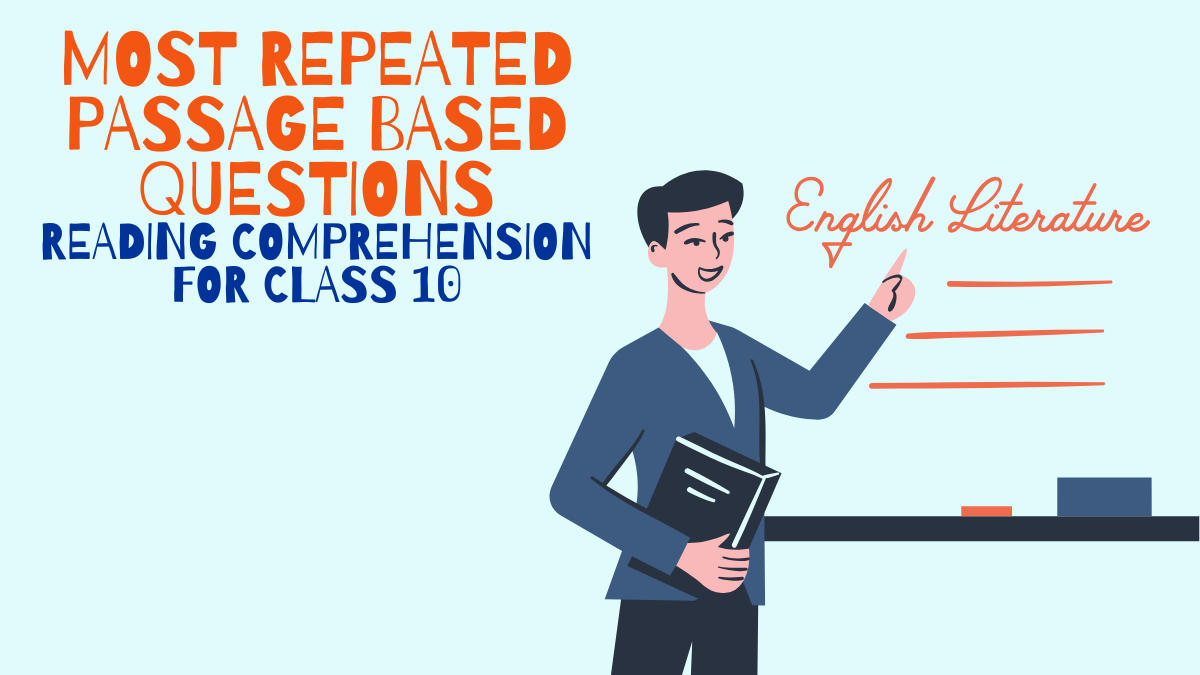Table of Contents
The Class 10 English question paper of Exams includes a portion with passage-based questions which is called Reading Comprehension (RC). To score better in this unseen passage, practice is necessary with multiple sample RCs. We have provided two Reading Comprehension questions and answers in this post which is ideal for last-minute practice. Important Passage Based Questions and Reading Comprehension for Class 10 allow you to improve your comprehension skills and test your ability to quickly assimilate information.
Passage Based Questions and Reading Comprehension for Class 10
Important Passage Based Questions and Reading Comprehension for Class 10 are intended to assess the student’s comprehension ability. To score well on the unseen passage-based question in this Board Exams 2025 students should attentively read the passage, comprehend the context, and then answer the questions based on their comprehension. Practicing the sample passages will also help you manage your time better throughout the English exam. You can evaluate your performance by reviewing the given correct answers to all questions and identifying areas for improvement.
Most Repeated Reading Comprehension for Class 10
Check out the completed Most repeated Reading Comprehensions below.
Passage – 1
- William Shakespeare’s Influence on English Literature
William Shakespeare, often referred to as the “Bard of Avon,” is regarded as one of the most influential writers in the history of English literature. His works, including 39 plays, 154 sonnets, and various poems, have profoundly impacted the English language, introducing new words, phrases, and expressions. His plays, ranging from comedies like A Midsummer Night’s Dream to tragedies like Hamlet, explore themes of love, power, betrayal, and the human condition, making them timeless.
- Themes in Shakespeare’s Plays
Shakespeare’s ability to capture complex human emotions and moral dilemmas is evident in his exploration of themes like ambition in Macbeth, jealousy in Othello, and revenge in Hamlet. His works also delve into social issues such as class division, gender roles, and the abuse of power. Shakespeare’s characters are multidimensional, and even his villains, like Iago in Othello and Lady Macbeth in Macbeth, are portrayed with depth, making them relatable to audiences even today.
- Language and Style
Shakespeare’s unique use of language is another key reason for his lasting legacy. He frequently employed iambic pentameter and blank verse in his writing, lending a rhythmic quality to his plays. His skill in creating memorable soliloquies, such as Hamlet’s famous “To be or not to be” speech, highlights his mastery of language and his ability to convey profound philosophical ideas through dialogue.
- Shakespeare’s Global Reach
Though Shakespeare wrote primarily for an English audience in the 16th and 17th centuries, his works have transcended time and geography. Today, Shakespeare’s plays are performed and studied worldwide, translated into numerous languages. Modern adaptations of his plays, in the form of films, theater productions, and literature, continue to introduce new generations to his genius. His influence can be seen in various art forms, and his works remain a cornerstone of literary education.
Questions:
- What is one of the reasons William Shakespeare is regarded as a highly influential writer?
- He wrote exclusively in prose
- He introduced new words and expressions to the English language
- He focused on writing only tragedies
- He wrote novels in addition to plays
- Which of the following themes is explored in
Macbeth?
- Ambition
- Revenge
- Jealousy
- Love
- Which character is NOT mentioned in the passage as a villain in Shakespeare’s plays?
- Iago
- Hamlet
- Lady Macbeth
- Othello
- What is iambic pentameter, as used by Shakespeare?
- A type of rhyme scheme
- A specific character archetype
- A rhythmic pattern of five pairs of syllables
- A form of prose writing
- According to the passage, Shakespeare’s works are:
- Only performed in English-speaking countries
- Limited to theater productions
- Studied and performed worldwide
- No longer relevant in modern literature
- True or False: Shakespeare only focused on love as a theme in his works.
- What famous soliloquy is mentioned in the passage, and in which play does it appear?
- Name one social issue that Shakespeare’s plays often explored, according to the passage.
- Fill in the blank: Shakespeare’s plays have been translated into numerous .
- The passage describes Shakespeare’s characters as , even when they are villains.
Solution:
(i) (b) He introduce new words and expressions to the English Language.
(ii) (a) Ambition
(iii) (b) Hamlet
(iv) (c) A rhythmic pattern of five pairs of syllables
(v) (c) Studied and performed worldwide
(vi) False
(vii) The soliloquy “To be or not to be,” from Hamlet
(viii) Class division or gender roles
(ix) Languages
(x) Multidimensional
Passage – 2
- Urbanization and Its Effects on Rural India
India has witnessed rapid urbanization over the past few decades. As cities expand, rural areas face several challenges, including the loss of agricultural land and traditional livelihoods. Many people from rural areas migrate to cities in search of better employment opportunities, resulting in a decline in the rural workforce. Urbanization has also led to the expansion of infrastructure, sometimes encroaching on fertile land and displacing farming communities.
- Economic Opportunities in Cities
The increasing number of industries and businesses in cities offers greater economic opportunities. Employment in sectors like manufacturing, construction, and services provides higher wages compared to agricultural work. However, this migration to urban areas has also created problems, such as overcrowded cities, inadequate housing, and pressure on urban resources like water and electricity. This influx has made it difficult for cities to sustain large populations without significant upgrades to infrastructure.
- Rural-Urban Divide
Despite the economic opportunities’ cities provide, the rural-urban divide in India continues to grow. Rural areas often lack access to quality education, healthcare, and sanitation compared to urban centers. Moreover, rural infrastructure, such as roads, power supply, and communication networks, remains underdeveloped. These disparities make life in rural areas difficult, pushing more people to leave their homes and relocate to cities.
- Solutions to Bridge the Gap
To address the challenges of rural-urban migration, the government has introduced initiatives like the Mahatma Gandhi National Rural Employment Guarantee Act (MGNREGA), which aims to provide rural jobs and prevent migration. Improving rural infrastructure, promoting rural industries, and enhancing access to education and healthcare can also help bridge the rural-urban divide. Additionally, sustainable urban planning is essential to accommodate the growing urban population without sacrificing rural land and resources.
(i) According to the passage, what is one of the main reasons for rural-urban migration in India?
(a) Lack of communication networks
(b) Expansion of rural industries
(c) Better employment opportunities in cities
(d) Decline in urban infrastructure
(ii) What issue has arisen due to the influx of people into cities?
(a) Expansion of agricultural land
(b) Improvement in rural-urban relations
(c) Overcrowded cities and pressure on resources
(d) Decrease in employment opportunities
(iii) What government initiative is mentioned in the passage that aims to provide jobs in rural areas?
(a) Kisan Credit Card Scheme
(b) Mahatma Gandhi National Rural Employment Guarantee Act(MGNREGA)
(c) Pradhan Mantri Fasal Bima Yojana
(d) Soil Health Card Scheme
(iv) Which sector is NOT mentioned as a source of employment in urban areas?
(a) Manufacturing
(c) Construction
(c) Services
(d) Agriculture
(v) The rural-urban divide continues to grow due to a lack of access to in rural areas.
(a)Education and healthcare
(b) Employment opportunities
(c) Water and electricity
(d) Political representation
(vi) True or False: According to the passage, migration to cities helps reduce overcrowding and improves urban resources.
(vii) What is one proposed solution to reduce rural- urban migration?
(viii) Which sector offers higher wages, prompting people to migrate to cities?
(ix) Fill in the blank: The passage suggests that the Mahatma Gandhi National Rural Employment Guarantee Act (MGNREGA) is aimed at preventing from rural areas to cities.
(x) Name one consequence of the expansion of urban infrastructure mentioned in the passage.
Solutions:
(i) (c) Better employment opportunities in cities
(ii) (c) Overcrowded cities and pressure on resources
(iii) (b) Mahatma Gandhi National Rural Employment Guarantee Act (MGNREGA)
(iv) (d) Agriculture
(v) (a) Education and healthcare
(vi) False
(vii) Improving rural infrastructure, promoting rural industries, and enhancing access to education and healthcare are proposed solutions.
(viii) Sectors like manufacturing, construction, and services offer higher wages.
(ix) Migration
(x) Encroachment on fertile land and displacement of farming communities.
Most Repeated Unseen Passage for Class 10 PDf
Also, don’t forget to download and practice more RC for full marks in your Class English Paper 2025.



 UP, MP, CBSE Board Result 2025 Live Upda...
UP, MP, CBSE Board Result 2025 Live Upda...
 [Live] CUET UG Date Sheet 2025 @cuet.nta...
[Live] CUET UG Date Sheet 2025 @cuet.nta...
 JEE Mains Result 2025 Session 2 Live: Sc...
JEE Mains Result 2025 Session 2 Live: Sc...

